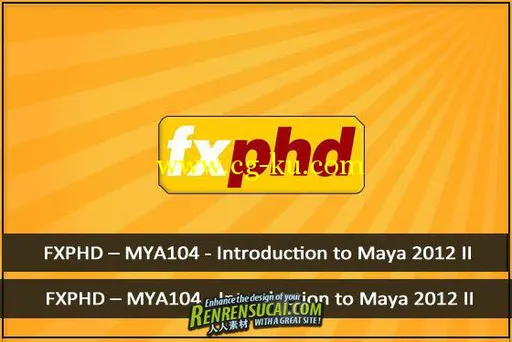本教程是由FXPHD机构出品的Maya2012综合训练教程,大小:2.51 GB,MP4视频格式,语言:英语。
当今大型电影绝伦的特效,不禁让你要惊叹其合成的逼真与强大!fxphd教育机构出品的教程,相信大家都知道,都为业界的高端教程。
Maya 是目前世界上最为优秀的三维动画的制作软件之一,主要是为了影视应用而研发的,所以在出世后不久就在《精灵鼠小弟》、《恐龙》等这些大片中一展身手。除了影视方面的应用外Maya在三维动画制作,影视广告设计,多媒体制作甚至游戏制作领域都有很出色的表现。初识Maya 是目前世界上最为优秀的三维动画的制作软件之一,它是Alias|Wavefront公司在CG数据库1998年才推出的三维制作软件。虽然相对于其他老牌三维制作软件来说Maya还是一个新生儿,但Maya凭借其强大的功能,友好的用户界面和丰富的视觉效果,一经推出就引起了动画和影视界的广泛关注,成为顶级的三维动画制作软件。
FXPHD MYA104 Introduction to Maya 2012 II
Taught by Matt Leonard, this Maya course is aimed at those who have little or no experience in 3D, or post-grads who know another system, such 3DS Max or Softimage but want to expand their software skills. It covers many new features of Maya 2012 and the Subscription Advantage Pack.
This course continues where MYA103 left off. We start by looking at character rigging and animation using the new Characterization Tool. We then move on to look at nDynamics (nParticles, nCloth) and Maya’s new Effects Assets. After break week we shift gears to look at Fur and Hair followed by Maya’s Fluid dynamics system and the new Liquid Simulations tool. Finally we finish up the term looking at the new Digital Molecular Matter plugin suite which can be used for various types of destruction effects.
Leonard has been in the 3D and visual effects industry for 19 years and has produced work for feature films, commercials and large corporate projects. He has spoken at various events and shows on behalf of Autodesk, The Foundry and eyeon Software and has had articles published in magazines and journals. He has worked as a beta tester for Maya, Mari, Mudbox, Nuke and Fusion. He currently runs his own on-site training company in the UK and has trained artists from companies such as Double Negative, Ghost VFX, Dreamworks Animation and Framestore.
Class 1: We start with Character Rigging. We begin to explore Maya’s joint system by rigging a cartoon style mouse which we’ll be using for a few classes. We look at how joints can be created and edited, along with Forward Kinematics and Inverse Kinematics and the use of Constraints.
Class 2: We continue with our Character Rigging. We start by looking at IK Handle and IK Spline Handle setups. We then look at the Connection Editor, Expressions and Set Driven Key. From there we attach the Joints to the Mesh using Smooth Bind and start to Paint the Weights of the CV’s help help the Mesh and Joints interact properly. Final we look at the Human IK system.
Class 3: Class 3: We finish with our Character Rigging project. We start by animating a simple walk cycle of our character, from there we cover various secondary animation systems such as Maya’s Jiggle deformer. Finally we look at Maya’s non-linear animation system, Trax.
Class 4: We start a new two class project looking at nDynamics including nCloth and nParticles. We start the class by building, texturing and lighting our 3D terrain. From there we create a water tower and fill it with particles. We go on to look at the Nucleus Solver and how it affects the particles. Finally we simulate the particles pouring out of the water tower and down the modeled ‘dry river bed’.
Class 5: We continue in this class looking at nDynamics. We start by looking at nCloth and how you can create both rigid and soft systems. We then look at how they can both interact with our particle water. From there we look at nConstraints and how an nCloth object can be ‘pinned’ and then released. Next week look at creating an nCloth cg-ku.com bag and filling it with particle balls before finishing up the lesson looking at Rigid Body’s though the creation of a wooden sign swaying in the wind before breaking.
Class 6: We return to characters in the form of a furry alien. We’ll start off looking at Hair and how to apply it to our pre-built and animated character. We’ll look at how you can control hair with constraints and collision objects, along with various combing techniques. We’ll finish up the class looking at rendering the hair.
Class 7: We move from Hair to Fur. Working with a cat model we’ll look at how Fur works inside of Maya, how it can be edited and how we can animate it. We’ll also look at various styles of Fur such as curly, clumpy, baldness and more. Finally we’ll look at rendering fur and the use of Deep Shadows.
Class 8: We begin our look at Maya’s Fluid Effects. In this first week we’ll focus on various types of Fluid Effects such as cloud, smoke and fire, and how the Fluids can be controlled and made to interact with each other and geometry. We’ll also look at rendering the Fluid effects.
Class 9: Our look at Maya Fluids continues. This week we’ll focus on the Open Water Simulations along with the new Liquid Simulations tool.
Class 10: In the final class we explore Maya 2012’s new plugin DMM (Digital Molecular Matter) which can be used to help you create highly realistic shatter, destruction, and deformation simulations that can include multiple interacting materials.
115网盘永久+迅雷离线地址:
http://kuai.xunlei.com/d/ULZVRDNIFNHD
http://kuai.xunlei.com/d/UYZCDXEWYDSW
http://kuai.xunlei.com/d/UKCLADMNUAVP
http://kuai.xunlei.com/d/UAACOVBXBZSG
或者
[thunder]Thunder://QUFmdHA6Ly9ycnNjOnJyc2NAMjIxLjIwOC4xMjMuMTk2L6G2TWF5YTIwMTLX27rP0bXBt73Ms8yht3JyLXNjLmNvbcjLyMvL2LLELnBhcnQ0LnJhcgpaWg==[/thunder]
[thunder]Thunder://QUFmdHA6Ly9ycnNjOnJyc2NAMjIxLjIwOC4xMjMuMTk2L6G2TWF5YTIwMTLX27rP0bXBt73Ms8yht3JyLXNjLmNvbcjLyMvL2LLELnBhcnQzLnJhcgpaWg==[/thunder]
[thunder]Thunder://QUFmdHA6Ly9ycnNjOnJyc2NAMjIxLjIwOC4xMjMuMTk2L6G2TWF5YTIwMTLX27rP0bXBt73Ms8yht3JyLXNjLmNvbcjLyMvL2LLELnBhcnQyLnJhcgpaWg==[/thunder]
[thunder]Thunder://QUFmdHA6Ly9ycnNjOnJyc2NAMjIxLjIwOC4xMjMuMTk2L6G2TWF5YTIwMTLX27rP0bXBt73Ms8yht3JyLXNjLmNvbcjLyMvL2LLELnBhcnQxLnJhcgpaWg==[/thunder]

发布日期: 2012-5-7